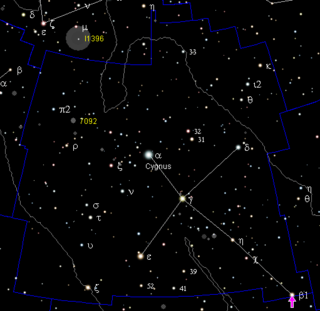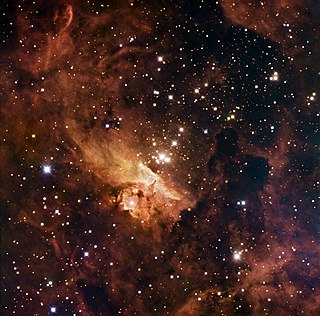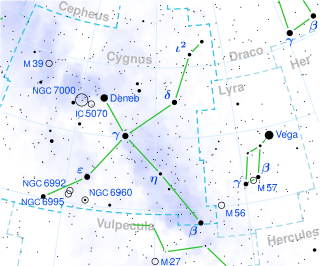
The Albireo system is a double star designated Beta Cygni. The International Astronomical Union uses the name "Albireo" specifically for the brightest star in the system. Although designated 'beta', it is fainter than Gamma Cygni, Delta Cygni, and Epsilon Cygni and is the fifth-brightest point of light in the constellation of Cygnus. Appearing to the naked eye to be a single star of magnitude 3, viewing through even a low-magnification telescope resolves it into its two components. The brighter yellow star makes a striking colour contrast with its fainter blue companion.

Delta Sagittarii, formally named Kaus Media, is a double star in the southern zodiac constellation of Sagittarius. The apparent visual magnitude of this star is +2.70, making it easily visible to the naked eye. Parallax measurements place the distance at roughly 348 light-years from the Sun.

Alpha Delphini is a multiple star system in the constellation of Delphinus.

Zeta Aquilae is a spectroscopic binary star in the equatorial constellation of Aquila. It is readily visible with the naked eye, being of the third magnitude. Based on parallax measurements obtained during the Hipparcos mission, it is approximately 83 light-years distant from the Sun.

9 Aurigae is a star system in Auriga (constellation). It has an apparent magnitude of about 5, making it visible to the naked eye in many suburban skies. Parallax estimates made by the Hipparcos spacecraft put it at about 85.7 light-years from the solar system.

Tau Canis Majoris is a multiple star system in the constellation Canis Major. It is approximately 5,000 light years distant from Earth and is the brightest member of the open cluster NGC 2362.

Gamma Cassiopeiae, Latinized from γ Cassiopeiae, is a star at the center of the distinctive "W" asterism in the northern circumpolar constellation of Cassiopeia. Although it is a fairly bright star with an apparent visual magnitude that varies from 1.6 to 3.0, it has no traditional Arabic or Latin name. It sometimes goes by the informal name Navi.

Phi Cassiopeiae is a star in the constellation Cassiopeia. φ Cassiopeiae is a multiple star with a combined apparent magnitude of +4.95. The two brightest components are A and C, sometimes called φ1 and φ2 Cas. φ Cas A is an F0 bright supergiant of magnitude 4.95 and φ Cas C is a 7.08 magnitude B6 supergiant at 134".

Pismis 24-1, also known as HD 319718, is the brightest star of the open cluster Pismis 24 within the nebula NGC 6357 about 6,500 light-years away. It was once thought to be the most massive star known, but is composed of at least three individual objects, each still among the most luminous and most massive stars known.

1 Vulpeculae is a class B4IV star in the constellation Vulpecula. Its apparent magnitude is 4.77 and it is approximately 780 light years away based on parallax.

9 Vulpeculae is a star in the northern constellation of Vulpecula, located about 550 light years away based on parallax. It is visible to the naked eye as a faint, blue-white hued star with a baseline apparent visual magnitude of 5.01. The star is moving further from the Earth with a heliocentric radial velocity of +5 km/s.

19 Cephei is a supergiant star in the northern circumpolar constellation of Cepheus. It has a spectral class of O9 and is a member of Cep OB2, an OB association of massive stars located about 615 parsecs (2,010 ly) from the Sun.

32 Cygni is the Flamsteed designation for a binary star system in the Cygnus constellation. It is a 4th magnitude star, which can be seen with the naked eye under suitably dark skies. Parallax measurements give an estimated distance of 1,100 light-years (320 parsecs) from the Earth. However, Schröder et al. (2007) suggest the actual value, after correcting for Malmquist bias, may be closer to 1,174 light-years (360 parsecs). Although it is a spectrsocopic binary with components that cannot be separated visually, it has two entries in the Henry Draper Catalogue, with identical magnitudes and positions, but showing the spectral types of the two components.

S Persei is a red supergiant or hypergiant located near the Double Cluster in Perseus, north of the cluster NGC 869. It is a member of the Perseus OB1 association and one of the largest known stars. If placed in our solar system, its photospehere would engulf the orbit of Jupiter. It is also a semiregular variable, a star whose variations are less regular than those of Mira variables.

X Persei is a high-mass X-ray binary system located in the constellation Perseus, approximately 950 parsecs away. It is catalogued as 4U 0352+309 in the final Uhuru catalog of X-ray objects.

10 Lacertae is a star in the constellation Lacerta. With an apparent magnitude of 4.9, it is located around 700 parsecs (2,300 ly) distant in the small Lacerta OB1 association. It is a hot blue main-sequence star of spectral type O9V, a massive star that is currently fusing its core hydrogen. It is a suspected Beta Cephei variable star.

Delta Monocerotis, which is Latinized from δ Monocerotis, is a single star in the constellation of Monoceros, positioned about a half degree south of the celestial equator. It has a white hue and is faintly visible to the naked eye with an apparent visual magnitude of 4.15. The distance to this star is approximately 384 light years based on parallax. It is drifting further away from the Sun with a radial velocity of about +15 km/s, having come to within 88 light-years some 7.3 million years ago. The star has an absolute magnitude of −1.20.

ξ Pavonis, Latinized as Xi Pavonis, is a triple star system in the southern constellation of Pavo. It is visible to the naked eye as a faint star with a combined apparent visual magnitude of 4.35 The system is located approximately 440 light years from the Sun based on parallax, and it is drifting further away with a radial velocity of +12 km/s.

λ1 Phoenicis, Latinized as Lambda1 Phoenicis, is a double star in the southern constellation of Phoenix. It is visible to the naked eye as a faint, white-hued point of light with a combined apparent visual magnitude of 4.76. The system is located approximately 183 light years away from the Sun based on parallax. It is a member of the Hyades Supercluster.

V520 Persei is a blue supergiant member of NGC 869, one of the Perseus Double Cluster open clusters. It is an irregular variable star.
















